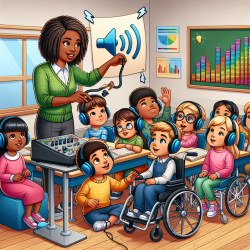In the realm of special education and inclusive classroom strategies, the pursuit of effective teaching methodologies remains paramount. Among these, the implementation of sound-field amplification systems in classrooms has emerged as a promising approach to enhance the listening environment for a diverse array of learners. This blog delves into the research presented in "The Effects of Sound-Field Amplification on Attending Behaviours" by Shauna Cornwell and Charlotte J. Evans, exploring its implications for educators and the potential benefits for students with and without attending and focusing difficulties.
Sound-field amplification systems, comprising wireless speaker and microphone setups, aim to elevate the teacher's voice above ambient classroom noise, ensuring clear auditory delivery to all students, irrespective of their seating position. This technology addresses the critical need for an optimal listening environment, crucial for effective learning and engagement.
The study by Cornwell and Evans provides compelling evidence of the positive impact of sound-field amplification on students' on-task behaviors. Observations in classrooms equipped with these systems showed a notable increase in the amount of time students spent engaged in learning activities. Particularly, students with attending difficulties demonstrated a 16% increase in on-task behavior when sound-field amplification was used, underscoring the system's potential to significantly enhance the educational experience for students facing challenges in maintaining focus.
Beyond the quantitative data, the qualitative feedback from both students and teachers further validates the value of sound-field amplification. Students reported improved clarity in hearing instructions and expressed a desire for the technology's broader implementation. Teachers observed quicker student responsiveness, reduced need for repetition, and an overall more conducive learning environment. Notably, teachers also benefited from reduced vocal strain and increased mobility, highlighting the system's holistic advantages.
Despite these positive outcomes, the study acknowledges the need for further research to explore long-term effects and the potential for sound-field amplification to improve comprehension and academic performance directly. Additionally, considerations regarding the cost, maintenance, and optimal configuration of these systems are critical for their effective integration into classroom settings.
For practitioners and educators seeking to enhance their teaching strategies, the findings from this study offer valuable insights. Implementing sound-field amplification can be a step towards creating more inclusive and effective learning environments, particularly for students with hearing and attention challenges. Moreover, this technology holds promise for supporting language acquisition among students learning English as a second language, further emphasizing its versatility and potential impact.
In conclusion, sound-field amplification systems represent a powerful tool in the quest to optimize classroom listening environments. By fostering increased student engagement and attentiveness, these systems can contribute to more effective teaching and learning outcomes. Educators are encouraged to consider the integration of sound-field amplification into their classrooms and to explore further research on its effects on student learning and behavior.
For those interested in delving deeper into the research and understanding the comprehensive benefits and considerations associated with sound-field amplification, reading the original study is highly recommended. To read the original research paper, please follow this link: The Effects of Sound-Field Amplification on Attending Behaviours.










